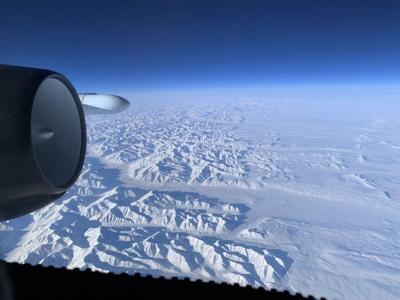A new study led by NOAA Research has confirmed that a substantial amount of groundwater contamination caused by perchlorates, a class of toxic chlorine-based chemicals, originates in a surprising place – the stratosphere. The study, led by researchers at NOAA’s Chemical Sciences Laboratory (CSL) and published in the journal Proceedings of the National Academies of Science, provides new evidence linking perchlorate formation to tiny airborne particles (aerosols) in the stratosphere, the layer of the atmosphere 7 to 30 miles above Earth’s surface.

Credit: NOAA / NASA
The study analyzed detailed aerosol chemical measurements collected from high-altitude research aircraft in the lower stratosphere, where the vast majority of particles in the thin air are made of sulfur dioxide. But the scientists found perchlorates were almost entirely bound to aerosol particles originating from biomass burning and nitrogen-rich sources, which are transported into the stratosphere by atmospheric circulation and by towering plumes of wildfire smoke. While these particles make up only a small fraction of the total stratospheric aerosol population, they carry nearly all of its perchlorate load.
“This was a real surprise,” said lead author Daniel Murphy, who heads CSL’s Aerosol Properties & Processes research program. “We found that perchlorate avoids the most common stratospheric aerosol particles, which are mostly sulfuric acid. Instead, it clings to particles with more organic content and less acidity—like those from wildfires.”
What is perchlorate?
Perchlorates, which are used in products such as rocket propellant, explosives, fireworks, batteries and automobile airbags, are known to disrupt thyroid function in humans. The precursor chlorine compounds that later form perchlorate originate from surface sources. Although some localized groundwater perchlorate contamination is the result of industrial pollution, past analyses of groundwater and snow samples have determined that most of the perchlorate at the surface was deposited after being formed in the atmosphere. Scientists had suspected a stratospheric source because of the presence of a tell-tale chlorine atom isotope (36Cl) in those samples. Their suspicion was bolstered by the observed trend of increasing perchlorate concentrations identified in snow from both Greenland and Antarctica that closely tracked increases in stratospheric chlorine from chemicals including chlorofluorocarbons (CFCs). CFCs were used as refrigerants and foam-blowing agents from the 1960s to 1990s, and were ultimately found to be the cause of the Antarctic ozone hole. The current study provides the first direct observations confirming that hypothesis.
Because the perchlorates are attached to particles, rather than persisting as a gas, they fall to the surface through gravitational settling and precipitation. Once at the surface, perchlorates are astonishingly long-lived, particularly in arid regions where they can build up over thousands of years.
“This study highlights that controls on CFCs by the Montreal Protocol, which were implemented because of the depletion of the ozone layer by chlorinated compounds, are preventing further perchlorate groundwater pollution,” said CSL Director David Fahey, a Co-chair of the Scientific Advisory Panel for the Montreal Protocol.
Science in the stratosphere
The new research draws on data collected from three major airborne missions: SABRE (Stratospheric Aerosol processes, Budget and Radiative Effects), DCOTSS (Dynamics and Chemistry of the Summer Stratosphere), and ATom (Atmospheric Tomography Mission), which were conducted between 2016 and 2024. Direct measurements were taken by an aerosol mass spectrometer called PALMS, which analyzed the composition of hundreds of thousands of individual aerosol particles during research flights that sampled the atmosphere from the surface to the stratosphere in both the Northern and Southern Hemispheres during multiple seasons.
The strongest perchlorate signals came from the stratosphere, especially in the mid- to high- latitudes, with more elevated levels observed in the Southern Hemisphere than the Northern Hemisphere. Despite abundant biomass burning and other less-acidic particle types near the surface, the researchers found virtually no perchlorate formation in the lower atmosphere.
More to learn
Murphy said detailed laboratory studies will be needed to answer many of the open questions about the exact chemical mechanism at work. It has yet to be determined, for example, whether these particles attract perchlorate that has already been formed in the atmosphere, or if perchlorate forms on their surfaces due to chemical reactions occurring in the stratosphere, as scientists suspect.
If perchlorates form directly on aerosol surfaces, it would imply that adding particles other than sulfuric acid to the stratosphere, either intentionally or unintentionally, could result in increased perchlorate production and subsequent deposition on the ground.
This would potentially have implications for climate intervention methods like stratospheric aerosol injection (SAI), which proposes injecting additional aerosols into the stratosphere to reflect sunlight and cool the planet. If perchlorate forms more easily on non-acidic particles, as this study suggests, then climate-driven increases in large wildfires or the use of light-reflecting particles like calcium carbonate might inadvertently increase perchlorate contamination.
“There’s a real caution here for things like SAI,” said Murphy. “Perchlorate is a reminder that stratospheric chemistry is not fully understood, and that manipulating it could bring unexpected consequences.”
For more information, contact Theo Stein, NOAA Communications: theo.stein@noaa.gov.












